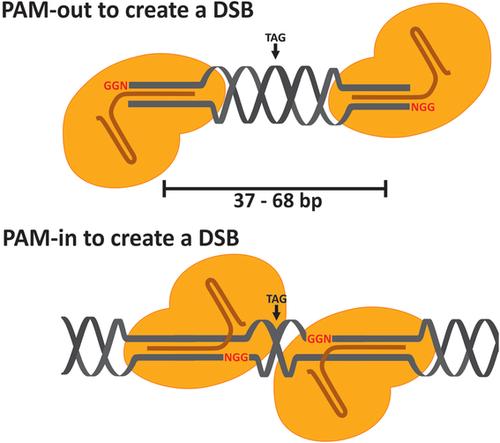下载PDF
{"title":"Design and Derivation of Multi-Reporter Pluripotent Stem Cell Lines via CRISPR/Cas9n-Mediated Homology-Directed Repair","authors":"Rabea Dettmer, Ortwin Naujok","doi":"10.1002/cpsc.116","DOIUrl":null,"url":null,"abstract":"<p>During the past decade, RNA-guided Cas9 nuclease from microbial clustered regularly interspaced short palindromic repeats (CRISPR/Cas9) has become a powerful tool for gene editing of human pluripotent stem cells (PSCs). Using paired CRISPR/Cas9 nickases (CRISPR/Cas9n) it is furthermore possible to reduce off-target effects that may typically occur with traditional CRISPR/Cas9 systems while maintaining high on-target efficiencies. With this technology and a well-designed homology-directed repair vector (HDR), we are now able to integrate transgenes into specific gene loci of PSCs in an allele conserving way. In this protocol we describe CRISPR/Cas9n design and homology directed repair vector design, transfection of human pluripotent stem cells and selection and expansion of generated cell clones. © 2020 The Authors.</p><p><b>Basic Protocol 1</b>: Repair template design and CRISPR/Cas9n construction</p><p><b>Basic Protocol 2</b>: Transfection of human pluripotent stem cells by electroporation</p><p><b>Basic Protocol 3</b>: Genotyping of generated cell clones</p>","PeriodicalId":53703,"journal":{"name":"Current Protocols in Stem Cell Biology","volume":"54 1","pages":""},"PeriodicalIF":0.0000,"publicationDate":"2020-07-06","publicationTypes":"Journal Article","fieldsOfStudy":null,"isOpenAccess":false,"openAccessPdf":"https://sci-hub-pdf.com/10.1002/cpsc.116","citationCount":"3","resultStr":null,"platform":"Semanticscholar","paperid":null,"PeriodicalName":"Current Protocols in Stem Cell Biology","FirstCategoryId":"1085","ListUrlMain":"https://onlinelibrary.wiley.com/doi/10.1002/cpsc.116","RegionNum":0,"RegionCategory":null,"ArticlePicture":[],"TitleCN":null,"AbstractTextCN":null,"PMCID":null,"EPubDate":"","PubModel":"","JCR":"Q2","JCRName":"Biochemistry, Genetics and Molecular Biology","Score":null,"Total":0}
引用次数: 3
引用
批量引用
Abstract
During the past decade, RNA-guided Cas9 nuclease from microbial clustered regularly interspaced short palindromic repeats (CRISPR/Cas9) has become a powerful tool for gene editing of human pluripotent stem cells (PSCs). Using paired CRISPR/Cas9 nickases (CRISPR/Cas9n) it is furthermore possible to reduce off-target effects that may typically occur with traditional CRISPR/Cas9 systems while maintaining high on-target efficiencies. With this technology and a well-designed homology-directed repair vector (HDR), we are now able to integrate transgenes into specific gene loci of PSCs in an allele conserving way. In this protocol we describe CRISPR/Cas9n design and homology directed repair vector design, transfection of human pluripotent stem cells and selection and expansion of generated cell clones. © 2020 The Authors.
Basic Protocol 1 : Repair template design and CRISPR/Cas9n construction
Basic Protocol 2 : Transfection of human pluripotent stem cells by electroporation
Basic Protocol 3 : Genotyping of generated cell clones
通过CRISPR/ cas9n介导的同源定向修复设计和衍生多报告多能干细胞系
在过去的十年中,来自微生物聚集规律间隔短回文重复序列(CRISPR/Cas9)的rna引导Cas9核酸酶已成为人类多能干细胞(PSCs)基因编辑的有力工具。使用配对的CRISPR/Cas9缺口酶(CRISPR/Cas9n),进一步有可能减少传统CRISPR/Cas9系统通常发生的脱靶效应,同时保持高靶向效率。利用这项技术和精心设计的同源定向修复载体(HDR),我们现在能够以等位基因保护的方式将转基因整合到PSCs的特定基因位点上。在本协议中,我们描述了CRISPR/Cas9n设计和同源定向修复载体设计,转染人类多能干细胞以及选择和扩增生成的细胞克隆。©2020作者。基本方案1:修复模板设计和CRISPR/Cas9n构建基本方案2:电穿孔转染人多能干细胞基本方案3:生成细胞克隆的基因分型
本文章由计算机程序翻译,如有差异,请以英文原文为准。



